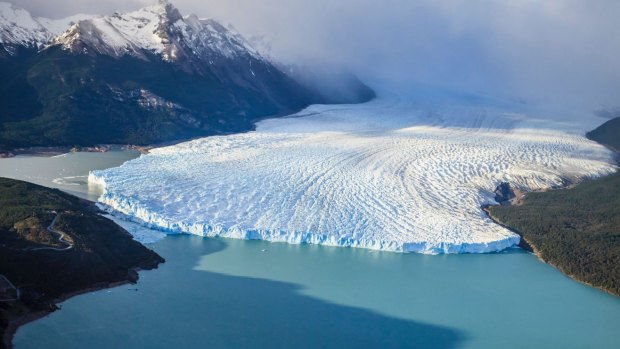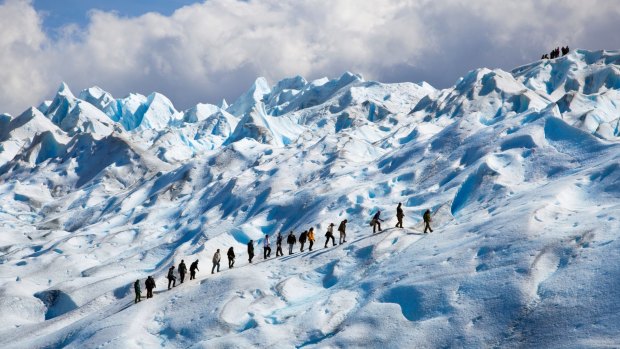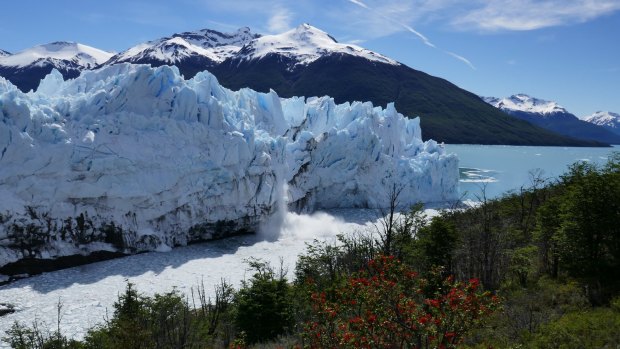This was published 6 years ago
Perito Moreno, Argentina travel guide: Will you have ice with that?
By Jim Darby
In a stand-off for number one natural feature, what are you backing? The glacier or the waterfall? If I'm the judge, it's no contest. The glacier has it before the bell.
What happens at a waterfall? The water goes over the edge, makes a crashing roar and sends up some annoying spray. And then it's a case of repeat, and repeat...
Want to change the course of a river? Get a bulldozer and you can dam it, divert it or divide it. You might get your bulldozer on to a glacier, but the crevasses will eat it alive.

The giant glacier from a distance.Credit: Blend Images / Alamy Stock Photo
Park yourself at a glacier wall and there is no way of knowing its next move. There could be a simple ice fall over here or a massive fracture and avalanche of ice blocks over there, with any one of the manoeuvres smashing the silence with a thunderous roar.
Waterfalls are so impatient. Victoria Falls and Iguazu Falls? They're both too steamy. Niagara Falls? Only the honeymooners won't notice being surrounded by honeymooners.
Give me a glacier like Patagonia's Perito Moreno any day, crashing as it does into Lake Argentina, in the vast Los Glaciares National Park.

Ice trekking on the Perito Moreno glacier.Credit: Alamy
The grumbling, stumbling prehistoric glacier is alive. Massive chunks of ice break away every few minutes from its north wall, growling their way into the water. Sometimes blocks as big as a 20-storey building collapse into the lake.
The ice wall rises 75 metres or more above the water in places and every now and again, the ice behind backs up to create a dam of water that takes years to build and eventually bursts, a one-off waterfall (once is enough) of spectacular proportions.
My guide and fellow glacier enthusiast, Alejandro Cainzos, explains that Patagonia is a podium-finisher when it comes to ice. The Southern Patagonian Icefield is the world's third-largest behind Greenland and, in top spot, Antarctica.

An ice fall or rupture at the wall of the Perito Moreno Glacier, Southern Patagonia. Credit: Jim Darby
The Perito Moreno is also crucial for regional tourism. Ten years ago, there might have been 300 visitors on a busy day in peak summer season, now there can be up to 4000.
That's a hint to visit in the shoulder times – spring or autumn – but they are well prepared to handle visitors en masse. There's no need to tumble through the forests and fire bush trying to catch a glimpse of the glacier – a network of walkways made of steel mesh with wooden handrails leads to a series of viewing platforms with good vantage points along the way.
There is a cafe and restaurant on site, but for maximum glacier time, stock up for lunch in El Calafate at the convenience stores or bakery. It's a tourist town with the usual line-up of souvenir and outdoor stores, but a highlight is a strip of local artisan studios, selling everything from jewellery and art to kits for the making of mate, the caffeine-rich Patagonian drink.
The drive to the glacier takes about an hour from El Calafate (itself about a 3½ flight from Buenos Aires) and the road trundles along over the Patagonian Steppe, mostly alongside the lake with snow-capped mountains to admire in the distance.
Alejandro asked if I'd like to stop for a drink, so with my two new mates – Alejandro the guide and Alexis Rossi, the driver (don't be alarmed by the surname, he's no Valentino Rossi, Alexis didn't top 80km/h in his Toyota Corolla), we tried some mate, the "drink of the gods".
It's made by pouring hot water over the leaves of the yerba-mate plant in a ceramic gourd and drinking it from the bottom through a metal straw. The custom is to share it around, so leave your germs at home.
If you're up for more, then you say muy bien (very good) but if you say muchos gracias (thanks very much) that tells your mate mates that you've had enough. I don't know that it'll take off among Australia's coffee hipsters; no chance for latte art with the leafy mate, but it is quite the reviver.
In the car, Alejandro explains that "it's the job of the co-pilot to make the conversation and to make the mate".
Some well-known mate drinkers? The egalitarian Pope Francis is a fan, as is the glamorous Queen Maxima of the Netherlands; not a complete surprise as both hail from Buenos Aires.
After our mate, we passed the Glacarium. A few minutes out of El Calafate, the Glacarium is part museum and part interpretation centre for the national park, the Southern Patagonian Icefield and the workings and wonders of glaciers. It's a very sharp piece of infrastructure for its museum-in-a-paddock location.
El Calafate is no major metropolis, but it also has a very polished and up-to-date airport to go with the Glacarium. It might help join the dots to know that Cristina Fernandez de Kirchner is from these parts. She was Argentina's president from 2007 to 2015, succeeding her late husband Nestor in the job.
I can't speak for CFK, as they like to call her, but I suspect she'd be a glacier fan. The Perito Moreno, which is handy to Casa Kirchner, is one of the few temperate-climate glaciers in the world that is growing, not receding, so she will have backed a winner there.
Although when she was president "for all Argentinians" she probably had to give a nod to those upstart Iguazu waterfalls.
TRIP NOTES
MORE
FLY
LATAM flies direct from Melbourne and Sydney to Santiago with connections through to Buenos Aires and El Calafate; see www.latam.com
STAY
In El Calafate, the hotel Kosten Aike is central with comfortable timber-lined rooms, capable and friendly staff and a simple buffet breakfast to get the day going. Rooms from $178, see www.kostenaike.com.ar
TOUR
You can self-drive but day tours make better sense for handling parking and other logistics at the glacier. Walking tours on the glacier and boat tours are also available. See www.southamericatravelcentre.com.au
Jim Darby travelled as a guest of LATAM and the South American Travel Centre.
FIVE MORE GREAT GLACIERS
UPSALA, LAKE ARGENTINA, ARGENTINA
A boat ride up the lake from Puerto Bandera, near El Calafate, takes you to this glacier's wall, with icebergs and stunning mountain views along the way.
VALLEE BLANCHE, CHAMONIX, FRANCE
Ride the cable car to the Aiguille du Midi and admire the glacier from a distance or find a guide and take a ski tour on it, all the way back to town if the snow cover is right.
TASMAN, MOUNT COOK/AORAKI, NEW ZEALAND
Head for glacier-central Mount Cook village. Depending on the season, the Tasman and the hanging glaciers that stick like candle wax along its sides can be explored by boat, 4WD, ski plane or helicopter.
GLACIER SKYWALK, ICEFIELDS PARKWAY, CANADA
The road from Banff to Jasper must be in the world's top-five mountain drives and now there's a viewing deck along the way, cantilevered out over the Columbia Icefield's Sunwapta Valley.
FOX, WEST COAST, NEW ZEALAND
On the South Island's more remote coast, heli-hikes and guided walks are the best ways to see the Fox. Back in town, grab a whitebait fritter or two in season.
Sign up for the Traveller Deals newsletter
Get exclusive travel deals delivered straight to your inbox. Sign up now.